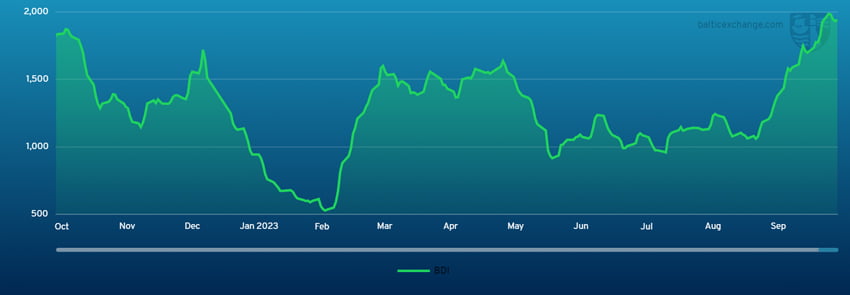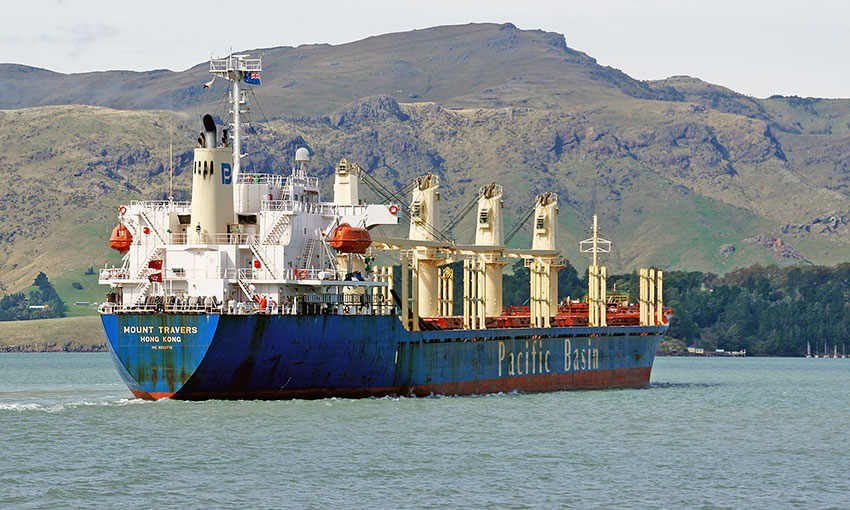THE BALTIC Dry Index hit a peak early last week before decreasing slightly to round out the week above the level seen at the end of the previous week/
The BDI hit 1991 on Monday (9 October), higher than the index has been in more than a year. The index then decreased slightly over the week and ended at 1945 on Friday (13 October).

Capesizes
Closing at US$27,591 the Capesize TC average maintained similar levels week-on-week, however large gains were seen on Monday when the spot rate climbed close to US$29,000, but neither Atlantic nor Pacific basin was lending much of the support by mid-week. The Brazil to Qingdao run declined from 26.378 last Friday to US$25.733, whilst the West Australia to Qingdao run declined about 70 cents week-on-week to mid US$10s. The North Atlantic tonnage list appeared tight with a healthy amount of fresh cargo lining up. Towards the end of the week, the transatlantic had shown the biggest improvement among all routes, settling at US$38,156. The sentiment in the Pacific was less robust overall. A transpacific round voyage paid US$22,782.
Panamax
After a promising opening to the week, activities in the Panamax market were slowly but surely became something of a grind as confidence eroded in both basins. The North Atlantic struggled for any momentum all week, South America saw a brief rally Monday/Tuesday with reports of an 81,000-dwt achieving US$18,000 delivery PMO for a trip via EC South America and other options to the Far East but petered off. Following various holidays last week, Asia returned with a bang particularly from Indonesia with a surge of fresh demand creating quite a stir, US$20,000 achieved for said run on a smaller LME type delivery Singapore, this had reverted to type by Friday with smaller LME types locking in at US$12,500 a few times. Aside from some Australian cape split coal stems evident, the longer round trips lacked any momentum. Period activity included an 82,000-dwt delivery China fixing at US$16,000 basis 4/6 months.
Ultramax/Supramax
The week started with high expectations however as it progressed it became a two-sided affair. Whilst sentiment generally remained positive in the Atlantic, from Asia the initial strengthening slipped away. Limited fresh enquiry was seen from South Asia and limited support from the NoPac saw gains being eroded. Period activity remained sluggish, although a 56,000-dwt open Continent was fixed for three to six months trading at US$16,000. Most gains in the Atlantic came from the US Gulf and South America with demand remaining for fronthaul business. A 60,000-dwt fixing a trip from Texas to China in the mid to upper US$20,000s. Some described the Continent-Mediterranean region as positional although a 61,000-dwt was fixed from the Baltic to Turkey basis delivery Continent at US$23,000. From Asia, stronger numbers at the start, a 63,000-dwt open Gresik fixed via Indonesia redelivery South China at US$22,000. From the Indian Ocean the undercurrent remained stable, a 63,000-dwt fixing delivery SE India via South Africa redelivery Pakistan/WC India at US$15,000.
Handysize
The overall sentiment in the handy sector became positive but visible activity in Asia remained minimal. With improved demand in the South Atlantic, levels have improved across the region with a large handy rumoured to have been fixed from Recalada to West Coast South America in the low US$20,000’s and a 36,000-dwt fixing from Cuba via Barcarena to Corninto at US$16,500. A 39,000-dwt opening in Jorf Lasfar was fixed via Brake to the US Gulf with an intended cargo of lumber at US$14,000 as an example of the Continent’s firmness. In Asia, whilst the market was said to be more balanced, a 38,000-dwt was rumoured to have been placed on subjects for a trip via Australia back to Southeast Asia at around US$13,000 and a 33,000-dwt opening in Wakayama fixed via Australia to Japan at US$9,000. Charterers had remained active in the period market with a 28,000-dwt opening in Indonesia rumoured to have fixed for four to six months at US$9,800.
Clean
LR2
LR’s in the MEG have undoubtedly been busy this week. Freight levels have as a result risen consistently throughout the week. TC1 added 8.89 points leaving the index currently at WS149.72 with the Baltic TCE for the run firmly back up over the US$30,000/day. For a trip west on a TC20 we have seen the index rise US$175,000 to over the US$4,000,000 level with reports of US$4,100,000 currently on subjects in the market.
West of Suez, Mediterranean/East LR2’s on TC15 reached a plateau this week after last week’s hop up, the index has floated around the US$3,200,000 mark.
LR1
In the MEG, LR1’s followed suit of their large sisters. On a TC5 run 55kt CPP AG/Japan the index rose 12.81 points to WS169.06 and WS170 widely reported as on subjects in the market. For a voyage west on TC8, there has also been a hop up to the tune of US$213,000 to US$3,610,000.
On the UK-Continent, the TC16 index remained resolute to continue along at the WS155 mark all week.
MR
Following last week’s significant improvement and despite demand continuing, MEG MR’s have taken a recorrect down this week. The TC17 index dipped 18.33 points to WS224.17.
UK-Continent MR’s looked to be subjected to what was coming this week after early week market activity reported as sombre. TC2 has shed 23.25 points to WS159.5 and TC19 similarly lost 21.57 points to WS170.31.
After some early week testing downward, its looks as though USG MR rates have reached a floor for the moment. TC14 dropped 15 points to WS125 where it has been for two days. TC18 mirrored this behaviour and is currently pegged at WS224.17 after an 18.33 points drop early in the week. For a run down to the Caribbean on TC21, we saw a 21% drop on index rate to US$781,667.
The MR Atlantic Triangulation Basket TCE lost US$6,358 to US$23,798.
Handymax
In the Mediterranean, Handymax’s made the biggest jump they have had for a long time. Market uncertainty that may have been generated by the geopolitical situation in the Eastern Mediterranean pushed the TC6 index to WS296.67 (+148.89) with a resettle back to the WS250’s at time of writing.
Up on the UK-Continent, the TC23 index crumbled 20% to WS169.44 after steady downward movements in the market all week.
VLCC
The Asian charterers returned this week after their recent holiday period, and the activity level dramatically increased alongside fixture rates and owners’ sentiment. The market is now significantly higher than in recent weeks and although October stems are said to be covered in the Middle East, November stem dates are due to be declared over the weekend, keeping the momentum firmly in the owners’ vice-like grip. The rate for 270,000 mt Middle East Gulf to China has climbed 17 points to WS53.04 corresponding to a daily round-trip TCE of US$27,963 basis Baltic Exchange’s vessel description. The 280,000mt Middle East Gulf to US Gulf trip (via the cape/cape routing) is now assessed 6.25 points higher at WS29.
In the Atlantic market, which started the firmer market early in the week, the 260,000mt West Africa/China rate rose 14.5 points week-on-week to WS55.55 (which shows a round voyage TCE of US$32,141/day). The rate for 270,000 mt US Gulf/China was last assessed yesterday (Thursday) US$1,133,333 higher at US$8,450,000 (US$32,689/day round trip TCE), although shortly after publication P66 were widely reported to have taken an Onassis vessel at US$9,300,000.
Suezmax
Suezmaxes in West Africa have had another positive week, with the rate for 130,000 mt Nigeria/UK Continent rocketing 37 points to WS109.32 (a daily round-trip TCE of US$42,487) and a few panellists were aware of total putting a Teekay ship on subjects at WS115 for TD20, with an option for South Africa at WS125. Several cargoes are still in play today in the fixing window and owners are now very bullish supported by a tight availability of tonnage. In the Mediterranean and Black Sea region, the 135,000 mt CPC/Med route gained 17 points to just shy of WS90 (showing a daily TCE US$23,425 round-trip). In the Middle East, the rate for 140,000 mt Middle East Gulf to the Mediterranean is now assessed 13 points higher than a week ago at WS70.83.
Aframax
In the North Sea, the rate for the 80,000 mt Cross-UK Continent route recovered by 14 points to WS113.21 (showing a round-trip daily TCE of US$19,182 basis Hound Point to Wilhelmshaven). In the Mediterranean market, the rate for 80,000 mt Cross-Mediterranean is 20 points firmer than last Friday at WS128.11(basis Ceyhan to Lavera, that shows a daily round trip TCE of US$29,310).
On the other side of the Atlantic, the market continued to firm, gathering pace on Wednesday and into Thursday. The rate for 70,000 mt East Coast Mexico/US Gulf has been catapulted 86 points to WS202.5 (a daily round-trip TCE of US$56,586) and the 70,000 mt Covenas/US Gulf trip received similar treatment and is now 79 points firmer at WS189.69 (a round-trip TCE of US$48,384/day). The rate for the trans-Atlantic route of 70,000 mt US Gulf/UK Continent is also on an upward trajectory, climbing 76 points to WS197.50 (a round trip TCE basis Houston/Rotterdam of US$51,193/day).
LNG
With few actual fixtures reported this week, the LNG market has seen further corrections down. At the same time last year we had been publishing at US$405,290 for BLNG1g a value US$275,782 higher than that with which we published today. For Aus-Japan a fall of US$34,100 on the week gave the index a value of US$129,508. A quiet lead up to winter market, few enquiries and tonnage availability outstripping current vessel demand is putting downward pressure on current rates. Unlike the issues faced last year with LNG availability, lack of ships and increased demand of sourcing LNG from alternative sources it seems so far, the market is on much weaker footing – at least from a freight rate perspective.
Out in the US the routes are relatively stable seeing small adjustments down only. However, when compared to the published price from a year ago, it is a very different story. With values closer to US$450,000 last year on both BLNG2g and BLNG3g versus less than half of that now; brokers are understandably confused as to where the bottom may be. Rates for Houston-UKC BLNG2g fell to US$131,341 while US-Japan lost just over US$10,000 to finish at US$159,055. There are still huge delays going through the Panama canal which will potentially shore up some rates, but with greater vessel availability this affect is so far muted.
LPG
It has again been quite a tumultuous week for the LPG Market. On BLPG1 Ras Tanura-Chiba we saw initially a reasonable gain moving up around US$11 by mid-week, but then as has been the fashion of late, it dropped off nearly US$13 to close at US$117.143 giving a daily TCE earning of US$102,640. With only a few fixtures reported with November laycans, there has been an easing of sentiment and despite the rate fluctuations, expectations are that it will remain uncertain even after the upcoming Saudi Aramco acceptances over the weekend.
The Atlantic has been steadier with both routes in the US losing value overall, huge delays in Panama coupled with lower cargo demand has put BLPG2 Houston-Flushing on a similar slide as BLPG1; gaining early on to finish US$1.8 down at US$119.8 (giving a daily TCE earning of US$142,229). BLPG3 Houston-Chiba had more directional movement losing US$12 overall to finish at US$213 and a daily TCE earning of US$126,126. Brokers have been expressing their exasperation trying to follow the market, with few fixtures actually confirmed but massive volatility and differing of opinions on the market LPG rates look set to continue to surprise.

